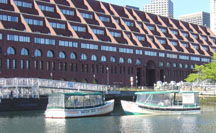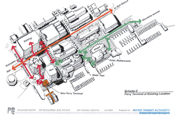Oakland’s Jack London Square has long been the kind of place only a Communist central planner could love. But exciting changes are in the works and this keystone of the East Bay waterfront figures to play an exciting and important role.

Published: August, 2002
Ferries Connecting with Buses, Trains and BART
Because four separate modes of public transportation converge upon or near Jack London Square, ferries, buses, trains, and BART, the Water Transit Authority (WTA), a regional ferry-planning agency, understands that Jack London Square can be a model for making good transit connections. When the California State Legislature created the WTA, it tasked the agency with planning for not only ferry expansion, but for convenient transit connections that give commuters and visitors the option of arriving at their destination without the use of a car.
Currently, the ferry terminal at Jack London Square serves mostly commute and recreation trips from the East Bay to San Francisco. However, Oakland’s job density coupled with new development, highlights its unfulfilled potential as not just an origin but also a destination for water transit. Approximately 900 housing units have been built in the Jack London Square area in the last three years and approximately 300 more units are planned. More hotel, retail, and entertainment spaces are also in the works.
The current collaboration between the Port of Oakland, the city’s local government, and the private development firm Jack London Square Partners (JLSP) will result in the renaissance of Jack London Square. Water transit alternatives such as ferries provide a good public transit option to San Francisco.
"We look at the development process we’re spearheading in Jack London Square as the opportunity to bring all these different transit entities together and to make it work," said Jim Falaschi, JLSP’s Principal Planner. "Our goal right now is to provide an incentive for the local transit authorities to help us move people to and from the ferry as smoothly as possible."
Jack London Square Partners is contemplating several possibilities for Oakland’s waterfront redevelopment that would make public transit a viable, commuter-friendly option along those lines. "We would like to see Oakland become the #2 largest hub of the water transit system," declared Mr. Falaschi, "and we’d like to take a leadership role in helping all of our transit authorities work together in a highly communicative way for the people of Oakland. But most of all, we want to turn Jack London Square into an asset not just for the locals but for all of the communities in the Bay Area."
Both the City of Oakland and the JLSP envision an infrastructure that will accommodate commuter-friendly transit needs. "We look to Boston as the urban waterfront model," said Mr. Falaschi, citing the coordination and communication of their transit
authorities. Boston’s Logan airport runs a free shuttle service from their terminals to a water taxi system that ships passengers into Boston Harbor. Once at the harbor, travelers are within close proximity to the "Blue Line" subway line that serves the downtown area.
Some of the proposed ideas for Jack London Square include moving the ferry terminal several blocks, from its present location at Clay Street to the foot of Broadway Street, bringing passengers closer to the Amtrak station by several hundred yards. Also, some have proposed incorporating AC Transit express bus lines that would run from the 12th St. BART station to 2nd St., thus avoiding the problematic turnaround area on Embarcadero. Unpredictable freight train schedules prevent buses from going to Jack London Square directly. The possibility of constructing another overhead walkway similar to Amtrak’s connective link to the Square has been mentioned as a pedestrian-friendly alternative to complement increased bus service. Finally, the addition of a "no-fare zone" within the Jack London area might be considered as a way to decrease lost time collecting fares.
JLSP remains dedicated to improving the city’s "green-friendly" ideal of public transit and living environments. The public process will play a large part in the decision-making process as well, and any potential changes will need to meet the approval of the area’s local residents. "Personally, as someone who lives in this neighborhood, I hope that the needs of Oakland’s citizens will play a part in deciding what happens," commented Peter Birkholz, Acting President of the Jack London Neighborhood Association (JLNA). "The idea of an express bus line linking the ferry to BART, for example, sounds great. I look forward to working though this phase with them and seeing what we can do to help."
As the JLSP’s website (http://www.jacklondonsquarepartners.com/project.html) states, the development process is a "public-private partnership" that requires the people of Oakland to participate. "It is up to the neighborhoods in regard to the process of moving the lines of communication along," stresses Mr. Falaschi, "but we want them to be involved." Meetings with the JLNA, ethnic Chambers of Commerce, local business associations, and individual apartment and loft complexes are scheduled to take place within the next few months.



